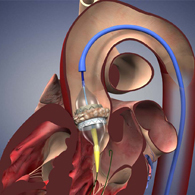FIRST "TAVR" IN SUFFOLK COUNTY IS PERFORMED TO PROVIDE TREATMENT FOR AORTIC STENOSIS
Offering Valve Surgery without Open Heart Surgery — Using New Minimally Invasive Procedure Suitable for Treating High-Risk Patients

from within the aorta, via catheter.
STONY BROOK, NY, December 11, 2012 — Stony Brook University Hospital has become the first hospital in Suffolk County to offer a new FDA-approved procedure to treat severe aortic stenosis (narrowing of aortic valve opening) by replacing the aortic valve with a prosthetic valve, without the need for open heart surgery.
Called transcatheter aortic valve replacement, or TAVR, this minimally invasive treatment offers new hope for high-risk patients with severe symptomatic aortic stenosis in need of life-saving valve replacement surgery.
Our first TAVR procedure was performed at the Stony Brook Heart Institut on November 21. Since then, other patients have been treated with it here, with more to have it done.
TAVR involves a multidisciplinary team of cardiologists and heart surgeons, who are valve specialists, working closely together, along with a vascular surgeon, echocardiographer, anesthesiologist, and pre- and post-operative care providers.
Stony Brook's TAVR program is leading the way in the new era in heart surgery, where valve surgery can be performed without the conventional "open heart" surgery, and more patients can be treated with it.
The surgeons who took part in the first procedure here were Co-Directors of the Heart Institute James R. Taylor Jr., MD, professor of surgery and chief of cardiothoracic surgery, and Harold A. Fernandez, MD, professor of surgery and deputy chief of cardiothoracic surgery Shang A. Loh, MD, assistant professor of surgery, who is a vascular surgeon and aorta specialist, also participated.
The interventional cardiologists on the TAVR team who participated in our first cases are Allen Jeremias, MD, Luis Gruberg, MD, and Jonathan B. Weinstein, DO.
Aortic stenosis is now the most frequently diagnosed heart valve disease. It is a potentially life-threatening condition, with a long latency period followed by rapid progression after the appearance of symptoms. Left untreated, 50% of patients with aortic stenosis die within two years of having symptoms.
Surgical replacement of the aortic valve reduces symptoms and improves survival in patients with this illness, and in the absence of serious co-existing medical issues, the procedure is associated with very good outcomes. However, 30% of patients with severe aortic stenosis can't undergo the conventional valve replacement surgery, because of their advanced age and/or the presence of multiple other illnesses.
For high-risk patients, a less invasive treatment has been long sought and, finally, the technology to achieve it has been developed, making this life-saving treatment now possible for these patients.
For these high-risk patients, a less invasive treatment has been sought and, finally, the technology to achieve it has been developed.
The new technology, approved by the FDA in the fall of 2011, is called the Edwards SAPIEN aortic valve replacement device. It is the first FDA-approved artificial aortic heart valve that's implanted without conventional "open heart" surgery.
Stony Brook University Hospital is now one of a select number of sites in the United States to offer TAVR that uses the Edwards SAPIEN transcatheter heart valve.
This innovative procedure delivers a replacement valve via catheter (thin tube) while the heart is still beatingsee What Happens during the TAVR Procedure">illustrated description of procedure).
Recovery time averages from one to two weeks. Patient selection and follow-up care involve a collaborative effort between referring physicians and our valve specialists.
| If you are a patient with severe aortic stenosis, or if you are a physician caring for a patient with this condition who could benefit from further evaluation, please call 631-638-2101 (Valve Center) or 631-444-1820 (Cardiothoracic Surgery Office) to make an appointment, or to obtain more information about our TAVR program. |


